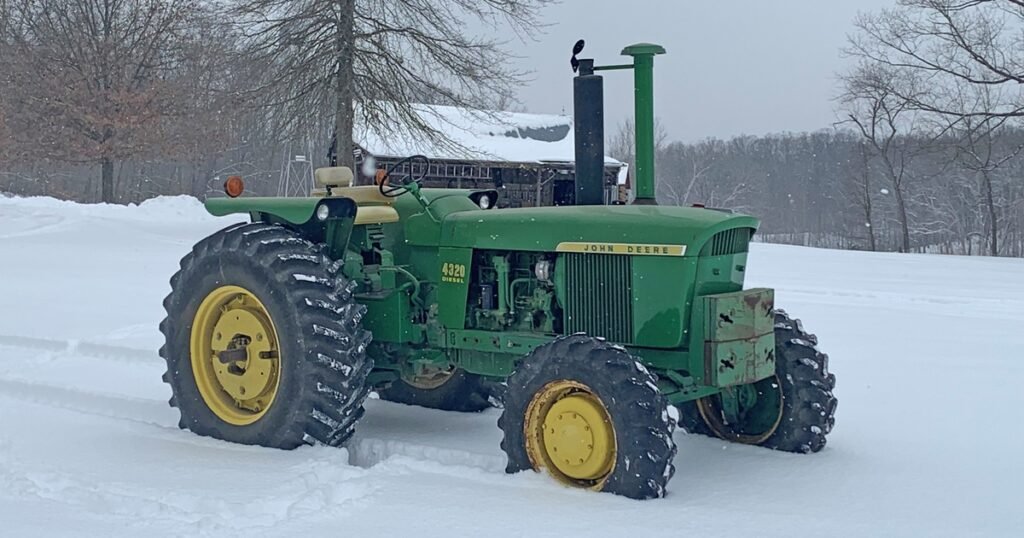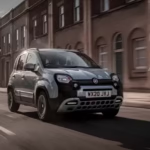Reseña del John Deere 4320
Ventajas
- + Fácil de mantener y reparar.
- + Excelente valor de reventa entre los modelos vintage.
- + Robusto motor diésel de 6,6 L y 6 cilindros
- + Rendimiento potente para su clase
- + Compatible con una variedad de implementos
- + Gran visibilidad y facilidad de uso
Contras
- – Sin opción de cabina de fábrica
- – Carece de electrónica y ergonomía modernas.

Producido durante solo dos años (1971-72), fue la apuesta más audaz de Deere en la carrera de caballos de fuerza a principios de los 70: una respuesta para los agricultores que buscaban más potencia sin pasarse a la tracción 4x4. Con 116 caballos en la toma de fuerza y un turbo de fábrica conectado al clásico motor 404, el 4320 no era solo un 4020 con un aumento de potencia, sino una evolución.
Sin cabina, sin sistema de emisiones, y nada superfluo. Solo diésel, acero y una ética de trabajo pura y analógica. Incluso ahora, es uno de los tractores pre-Sound-Gard más codiciados que Deere haya fabricado.
¿Qué hay de nuevo para esta generación?
Todo y nada. El 4320 fue un modelo único, construido sobre la base del apreciado 4020, pero con importantes mejoras internas.
Esta fue la primera vez que John Deere incorporó un turbocompresor a un tractor de cultivo en hileras directamente de fábrica. Esto se tradujo en más potencia, más par motor y mucha más capacidad, sin modificar el diseño habitual del tractor ni añadir complejidad.
El 4320 también recibió una parte trasera reforzada y mejor refrigeración para complementar la mayor potencia. Pero más allá de eso, Deere mantuvo la simplicidad. Sin lujos ni artificios. Simplemente una herramienta agrícola increíblemente eficaz.
Precios y cuál comprar
En 1972, se podía conseguir un 4320 nuevo por unos 11.000 TP/T. ¿Hoy? Un ejemplar impecable con la chapa original y el turbo de fábrica costaría entre 25.000 y 40.000 TP/T, y a veces más si ha sido restaurado o tiene pocas horas.
Este es el sueño de cualquier coleccionista y un caballo de batalla, todo a la vez. No se están fabricando más, y la demanda no ha bajado ni un ápice.
Configuración recomendada:
- Modelo turboalimentado de fábrica (no es un complemento del mercado de accesorios)
- Transmisión Syncro-Range para simplicidad y longevidad
- Ruedas traseras dobles si va a tirar herramientas pesadas
- ROPS y parasol si planeas usarlo todo el día
Motor, transmisión y rendimiento
Bajo el capó se encuentra el probado motor diésel de seis cilindros en línea de 404 pulgadas cúbicas de Deere, turboalimentado y optimizado para generar 116 caballos de fuerza con toma de fuerza. Son 20 más que un 4020, y se nota. Este motor no solo es potente, sino que también tiene una curva de par más plana que un trigal de Kansas.
El turbo gira suavemente y el motor nunca se queda sin aliento, incluso cuando se tira de una labranza pesada o se utilizan equipos grandes de toma de fuerza.
Las opciones de transmisión fueron simples pero sólidas:
- Rango de sincronización: 8 marchas adelante, 2 marchas atrás, cambio manual con varillaje mecánico. Sencillísimo. Sólido como una roca.
No había opción Power Shift en el 4320. Pero para la mayoría de los trabajos, Syncro es suficiente y más fácil de mantener a largo plazo.
La velocidad máxima es de unos 29 km/h. ¿Aceleración? Constante y serena. No es rápido, pero tira con determinación.
Economía de combustible y uso en el mundo real

El 4320 se centra en la eficiencia a la antigua usanza: sin computadoras, sin sistemas de emisiones, sin DEF. Solo un gran turbodiésel que respira con fuerza a través de conductos de combustible de acero.
Espere de 5 a 7 galones por hora con carga de campo, un poco menos para trabajos ligeros. Su tanque de 35 galones le permitirá trabajar una jornada completa sin necesidad de rellenarlo, a menos que esté trabajando con un arado de cincel en tierra pesada.
En la práctica, se encarga de casi cualquier cosa:
- Arado de 5 o 6 fondos
- Sembradora de 12 hileras
- empacadora redonda
- Carro de granos
- Cargador (con algo de peso frontal añadido)
Hoy en día sigue siendo una máquina viable para granjas pequeñas y medianas.
Interior, comodidad y experiencia del operador
No hay taxi, solo una estación al aire libre, pisos de acero y el zumbido del diésel en los oídos.
¿Pero para su época? Es increíblemente útil. Los controles están ubicados con la lógica característica de Deere, y todo lo que necesitas está al alcance de la mano. La visibilidad es excelente en todas direcciones. El asiento no es lujoso, pero cumple su función.
Agregue un toldo ROPS y se convierte en un lugar bastante cómodo para pasar 10 horas.
No hay aislamiento, ni climatización, ni portavasos. Pero cuando estás sentado, todo es cuestión de trabajo, y así es como debe ser.
Infoentretenimiento y conectividad
No encontrarás Bluetooth, pantallas ni puertos de diagnóstico. Lo que obtienes es un tablero de acero con:
- tacómetro analógico
- Manómetro de presión de aceite
- Temperatura del refrigerante
- Amperímetro
Eso es todo. Sin distracciones. Sin advertencias que desaparecen a los tres segundos. Y lo mejor de todo, no requiere actualizaciones. Si algo falla, lo arreglas. No necesitas soporte técnico.
Seguridad y facilidad de uso

No hay nada automático aquí, pero es sólido y predecible.
Lo que obtienes:
- Barra ROPS opcional (consiga una si no la tiene)
- Frenos de tambor hidráulicos
- Dirección sencilla
- Mucho peso y tracción
Los controles son mecánicos y precisos: las palancas hacen clic, los pedales se sienten firmes y el embrague se acopla con suavidad. Siempre sabes lo que hace la máquina.
Para los operadores experimentados, es algo natural. ¿Para los conductores noveles? Hay una curva de aprendizaje, pero te enseña a prestar atención, y eso no está nada mal.
Mantenimiento y confiabilidad
Si la confiabilidad tuviera un sonido, sería un 4320 funcionando a 900 RPM.
Todo en este tractor está diseñado para durar y es fácil de usar. El motor 404 es conocido por su durabilidad y rendimiento, con un mantenimiento básico. Filtros de combustible, cambios de aceite y ajustes de válvulas: todo es sencillo y accesible.
La transmisión Synchro-Range es prácticamente indestructible si no se abusa de ella. Los ejes traseros son lo suficientemente resistentes como para soportar dobles y cargas pesadas. El sistema hidráulico es sensible y fácil de mantener.
¿Repuestos? Aún disponibles. Y gracias a la intercambiabilidad de piezas del 4020, es uno de los Deer clásicos más fáciles de mantener en funcionamiento.
Veredicto
El John Deere 4320 no duró mucho, pero dejó huella. Era el tractor de dos ruedas motrices para cultivos en hileras más potente que Deere había fabricado hasta entonces, y lo hacía sin comprometer la simplicidad ni la facilidad de mantenimiento.
Sin cabina. Sin lujos. Solo torque turboalimentado e ingeniería mecánica impecable que ha resistido el paso del tiempo.
No es tan común como el 4020. No es tan llamativo como el 4440. Pero el 4320 ocupa un lugar destacado en la historia de Deere: potencia de verdad en un paquete clásico y analógico. Y para los agricultores que buscan potencia real sin complicaciones, no hay nada mejor.
Sigue siendo atractivo. Sigue siendo relevante. Sigue valiendo cada centavo.
Presupuesto
Información general | |
| Fabricante | John Deere |
| Nombre del modelo | 4320 |
| Tipo de vehículo | Tractor agrícola |
| Estilo de carrocería | Tractor para cultivos en hileras |
| Años de producción | 1971–1972 |
| Ubicación de fabricación | Waterloo, Iowa, Estados Unidos |
| Precio original (1972) | ~$10,345 USD |
Potencia y rendimiento | |
| Tipo de motor | John Deere 6.6L 6 cilindros diésel turboalimentado |
| Cilindrada del motor | 6,6 litros (404 ci) |
| Caballos de fuerza (TDF) | 115 caballos (85,8 kW) |
| Caballos de fuerza (barra de tiro) | 97 caballos (72,3 kW) |
| Velocidad nominal del motor | 2200 rpm |
| Esfuerzo de torsión | Aprox. 392 Nm (289 ft-lbs) |
| Tipo de combustible | Diesel |
| Capacidad de combustible | 128,7 litros (34 galones estadounidenses) |
Transmisión y tren motriz | |
| Transmisión | Rango de sincronización |
| Engranajes | 8 adelante / 2 atrás |
| Tipo de unidad | 2WD (estándar) |
| Embrague | Disco seco |
Hidráulica y toma de fuerza | |
| Sistema hidráulico | Centro cerrado |
| Flujo de la bomba | 22,7 galones por minuto (86 lpm) |
| Toma de fuerza trasera | 1000 rpm |
| Enganche trasero | Categoría II |
| Capacidad de elevación | Aprox. 2.722 kg (6.000 libras) |
Dimensiones y peso | |
| Longitud | 3.810 mm (150 pulgadas) |
| Ancho | 2.440 mm (96 pulgadas) |
| Altura (volante) | 2.150 mm (84,6 pulgadas) |
| Distancia entre ejes | 2.540 mm (100 pulgadas) |
| Peso (Envío) | 4.264 kg (9.400 libras) |
| Peso (en funcionamiento) | 4.627 kg (10.200 libras) |
| Distancia al suelo | 420 mm (16,5 pulgadas) |
Características notables | |
| Taxi | Estación abierta (dosel opcional) |
| Frenos | Disco húmedo hidráulico |
| Gobierno | Dirección asistida |
| Iluminación | Luces de trabajo incandescentes básicas |
| Instrumentación | Indicadores analógicos con tacómetro, contador de horas y nivel de combustible. |
Variantes | |
| John Deere 4320 (estándar) | 2WD, transmisión Synchro-Range |
Colores de pintura disponibles |
| John Deere clásico verde con ruedas amarillas |





